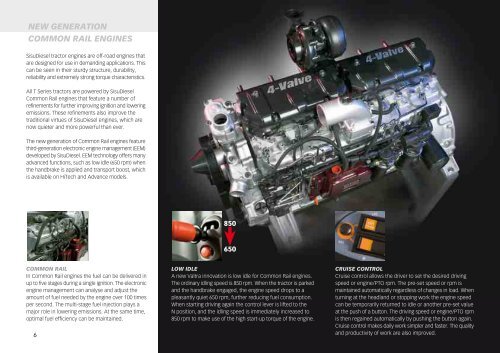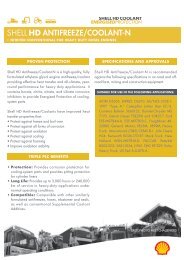T Series - Valtra
T Series - Valtra
T Series - Valtra
- No tags were found...
Create successful ePaper yourself
Turn your PDF publications into a flip-book with our unique Google optimized e-Paper software.
NEW GENERATION<br />
COMMON RAIL ENGINES<br />
SisuDiesel tractor engines are off-road engines that<br />
are designed for use in demanding applications. This<br />
can be seen in their sturdy structure, durability,<br />
reliability and extremely strong torque characteristics.<br />
All T <strong>Series</strong> tractors are powered by SisuDiesel<br />
Common Rail engines that feature a number of<br />
refinements for further improving ignition and lowering<br />
emissions. These refinements also improve the<br />
traditional virtues of SisuDiesel engines, which are<br />
now quieter and more powerful than ever.<br />
The new generation of Common Rail engines feature<br />
third-generation electronic engine management (EEM)<br />
developed by SisuDiesel. EEM technology offers many<br />
advanced functions, such as low idle (650 rpm) when<br />
the handbrake is applied and transport boost, which<br />
is available on HiTech and Advance models.<br />
850<br />
650<br />
COMMON RAIL<br />
In Common Rail engines the fuel can be delivered in<br />
up to five stages during a single ignition. The electronic<br />
engine management can analyse and adjust the<br />
amount of fuel needed by the engine over 100 times<br />
per second. The multi-stage fuel injection plays a<br />
major role in lowering emissions. At the same time,<br />
optimal fuel efficiency can be maintained.<br />
6<br />
LOW IDLE<br />
A new <strong>Valtra</strong> innovation is low idle for Common Rail engines.<br />
The ordinary idling speed is 850 rpm. When the tractor is parked<br />
and the handbrake engaged, the engine speed drops to a<br />
pleasantly quiet 650 rpm, further reducing fuel consumption.<br />
When starting driving again the control lever is lifted to the<br />
N position, and the idling speed is immediately increased to<br />
850 rpm to make use of the high start-up torque of the engine.<br />
CRUISE CONTROL<br />
Cruise control allows the driver to set the desired driving<br />
speed or engine/PTO rpm. The pre-set speed or rpm is<br />
maintained automatically regardless of changes in load. When<br />
turning at the headland or stopping work the engine speed<br />
can be temporarily returned to idle or another pre-set value<br />
at the push of a button. The driving speed or engine/PTO rpm<br />
is then regained automatically by pushing the button again.<br />
Cruise control makes daily work simpler and faster. The quality<br />
and productivity of work are also improved.




